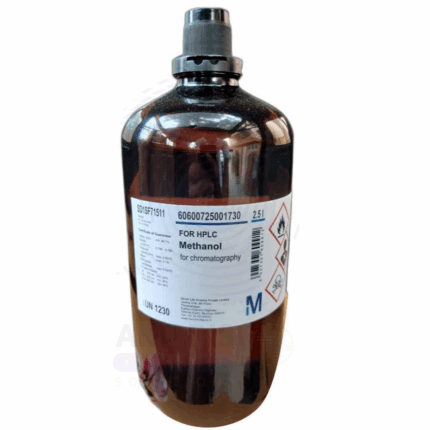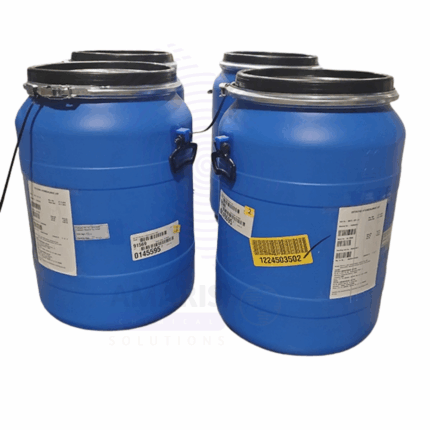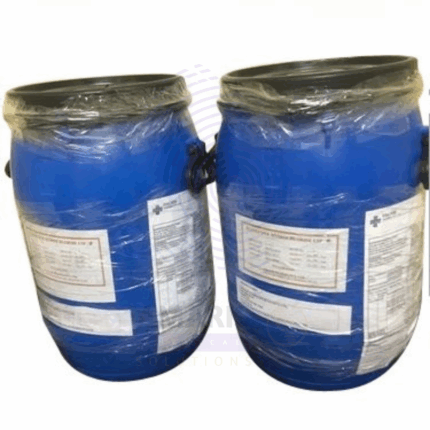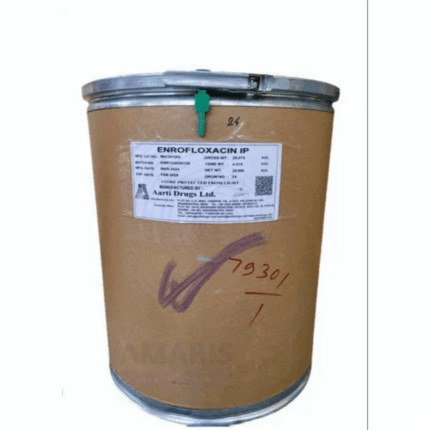

Dextromethorphan Hydrobromide (Dextromethorphan HBr)
Dextromethorphan Hydrobromide (Dextromethorphan HBr) is a synthetic derivative of morphinan and a widely used antitussive agent that suppresses cough reflex. It acts centrally on the cough center in the medulla without causing typical opioid side effects such as analgesia or dependence. It is commonly formulated in syrups, tablets, lozenges, and combination cold and flu medications. Due to its rapid onset, good oral bioavailability, and well-tolerated safety profile, Dextromethorphan HBr is a preferred active pharmaceutical ingredient (API) in cough suppressant products worldwide.
Dextromethorphan Hydrobromide (Dextromethorphan HBr) Uses
- Primary Uses
- Pharmaceutical Cough Suppressants
- Used as an effective antitussive agent in over-the-counter and prescription medications to relieve dry, non-productive coughs.
- Incorporated into syrup, capsule, tablet, lozenge, and inhalation formulations.
- Employed in combination with decongestants, antihistamines, or expectorants to treat multi-symptom cold and flu products.
- Neurological Research
- Investigated for its NMDA receptor antagonist activity with potential applications in neuroprotection and psychiatric disorders research.
- Pediatric Formulations
- Included in pediatric cold and cough syrups at appropriate dosing for symptomatic relief in children (dosage strictly controlled).
Secondary Uses
- Potential Off-label Research
- Explored experimentally for effects on neuropathic pain and other CNS conditions.
- Recreational Substance (Illicit Use Concern)
- Known for abuse potential at high doses causing dissociative and psychoactive effects; regulated accordingly.
- Basic Identification Attributes
- Chemical Name (IUPAC): (–)-3-Methoxy-17-methylmorphinan hydrobromide
- Common/Trade Name: Dextromethorphan HBr
- CAS Number: 125-71-3
- HS Code: 2939.99.99
- Molecular Formula: C18H25NO · HBr
- Synonyms:
- Dextromethorphan Hydrobromide
- Dextromethorphan Bromide Salt
- Dextromethorphan HBr
- Dextromethorphan Hydrobromide USP
- Dextromethorphan Hydrobromide Monohydrate (if hydrated)
- Physical & Chemical Properties
- Physical State: White or off-white crystalline powder
- Solubility: Freely soluble in water and ethanol
- Melting Point: Approximately 171–174°C
- pH (1% aqueous solution): Neutral to slightly acidic
- Stability: Stable under normal storage; sensitive to strong oxidizers and light degradation
- Molecular Weight: 335.31 g/mol (anhydrous)
- Appearance: Fine crystalline powder
- Safety & Hazard Attributes
- Hazard Class (GHS): Generally low hazard; handle as pharmaceutical-grade compound
- Toxicity: Low to moderate oral toxicity; high doses may cause CNS effects and toxicity
- Irritation: May cause mild skin or eye irritation; avoid inhalation of dust
- Abuse Potential: Controlled substance in many jurisdictions due to abuse potential at high doses
- Storage & Handling Attributes
- Storage Conditions: Store in a cool, dry, dark place, preferably 15–25°C
- Container Type: Airtight, moisture-proof containers such as glass or HDPE bottles
- Shelf Life: Typically 2–3 years if stored properly
- Handling Precautions: Use PPE to avoid dust inhalation and skin/eye contact; handle in well-ventilated areas
- Regulatory & Compliance Attributes
- Regulatory Status: Approved as an antitussive agent by FDA, EMA, and other global regulatory bodies
- Pharmacopoeia Standards: USP, EP grades available
- Controlled Substance: Regulated in many countries due to abuse potential; restrictions on sales and distribution
- Transportation: Non-hazardous under standard transport regulations but subject to controlled substance rules in some regions
- Environmental & Health Impact
- Biodegradability: Limited data; expected to degrade under normal environmental conditions
- Ecotoxicity: Not well documented; precaution advised in disposal
- Bioaccumulation: Not expected
- Carcinogenicity/Mutagenicity: No evidence of carcinogenic or mutagenic effects
Safety Handling Precautions
- PPE Required:
- Dust mask or respirator during powder handling
- Safety goggles
- Gloves (nitrile or latex)
- Lab coat or protective clothing
- Handling Guidelines:
- Minimize dust generation
- Avoid inhalation and direct contact with skin or eyes
- Use in well-ventilated areas or fume hoods if handling large quantities
- Storage Measures:
- Keep containers tightly closed and dry
- Protect from light and moisture
- Hygiene Practices:
- No eating, drinking, or smoking during handling
- Wash hands thoroughly after handling
First Aid Measures
- Inhalation: Move to fresh air; seek medical attention if respiratory irritation or distress occurs
- Skin Contact: Wash with soap and water; seek medical advice if irritation persists
- Eye Contact: Rinse immediately with plenty of water for 15 minutes; seek medical attention
- Ingestion: Seek medical advice; supportive treatment for overdose symptoms as required
Firefighting Measures
- Fire Hazard: Combustible powder; dust may pose explosion risk in confined spaces
- Extinguishing Media: Water spray, foam, dry chemical, CO₂
- Special Precautions: Avoid dust dispersion; use appropriate respiratory protection
Decomposition Products: May emit carbon oxides, nitrogen oxides, and hydrogen bromide upon combustion


 Preservatives(food)
Preservatives(food) Flavor Enhancers
Flavor Enhancers Acidulants
Acidulants Sweeteners
Sweeteners Antioxidants
Antioxidants Colorants(food)
Colorants(food) Nutraceutical Ingredients (food)
Nutraceutical Ingredients (food) Nutrient Supplements
Nutrient Supplements Emulsifiers
Emulsifiers
 Collectors
Collectors Dust Suppressants
Dust Suppressants Explosives and Blasting Agents
Explosives and Blasting Agents Flocculants and Coagulants
Flocculants and Coagulants Frothers
Frothers Leaching Agents
Leaching Agents pH Modifiers
pH Modifiers Precious Metal Extraction Agents
Precious Metal Extraction Agents
 Antioxidants(plastic)
Antioxidants(plastic) Colorants (Pigments, Dyes)
Colorants (Pigments, Dyes) Fillers and Reinforcements
Fillers and Reinforcements Flame Retardants
Flame Retardants Monomers
Monomers Plasticizers
Plasticizers Polymerization Initiators
Polymerization Initiators Stabilizers (UV, Heat)
Stabilizers (UV, Heat)
 Antifoaming Agents
Antifoaming Agents Chelating Agents
Chelating Agents Coagulants and Flocculants
Coagulants and Flocculants Corrosion Inhibitors
Corrosion Inhibitors Disinfectants and Biocides
Disinfectants and Biocides Oxidizing Agents
Oxidizing Agents pH Adjusters
pH Adjusters Scale Inhibitors( water)
Scale Inhibitors( water)
 Antioxidants(cosmetic)
Antioxidants(cosmetic) Emollients
Emollients Fragrances and Essential Oils
Fragrances and Essential Oils Humectants
Humectants Preservatives
Preservatives Surfactants(cosmetic)
Surfactants(cosmetic) Thickeners
Thickeners UV Filters
UV Filters
 Fertilizers
Fertilizers Soil Conditioners
Soil Conditioners Plant Growth Regulators
Plant Growth Regulators Animal Feed Additives
Animal Feed Additives Biostimulants
Biostimulants Pesticides (Herbicides, Insecticides, Fungicides)
Pesticides (Herbicides, Insecticides, Fungicides)
 Active Pharmaceutical Ingredients (APIs)
Active Pharmaceutical Ingredients (APIs) Excipients
Excipients Solvents(pharmaceutical)
Solvents(pharmaceutical) Antibiotics
Antibiotics Antiseptics and Disinfectants
Antiseptics and Disinfectants Vaccine Adjuvants
Vaccine Adjuvants Nutraceutical Ingredients (pharmaceutical)
Nutraceutical Ingredients (pharmaceutical) Analgesics & Antipyretics
Analgesics & Antipyretics
 Analytical Reagents
Analytical Reagents Solvents(lab)
Solvents(lab) Chromatography Chemicals
Chromatography Chemicals Spectroscopy Reagents
Spectroscopy Reagents microbiology-and-cell-culture-reagents
microbiology-and-cell-culture-reagents Molecular Biology Reagents
Molecular Biology Reagents Biochemical Reagents
Biochemical Reagents Inorganic and Organic Standards
Inorganic and Organic Standards Laboratory Safety Chemicals
Laboratory Safety Chemicals Specialty Laboratory Chemicals(Special Laboratory Equipment)
Specialty Laboratory Chemicals(Special Laboratory Equipment)
 Demulsifiers
Demulsifiers Hydraulic Fracturing Fluids
Hydraulic Fracturing Fluids Scale Inhibitors(oil)
Scale Inhibitors(oil) Surfactants(oil)
Surfactants(oil) Drilling Fluids
Drilling Fluids
 Dyes and Pigments
Dyes and Pigments Bleaching Agents
Bleaching Agents Softening Agents
Softening Agents Finishing Agents
Finishing Agents Antistatic Agents
Antistatic Agents
 Admixtures
Admixtures Waterproofing Agents
Waterproofing Agents Sealants and Adhesives
Sealants and Adhesives Curing Compounds
Curing Compounds Concrete Repair Chemicals
Concrete Repair Chemicals Anti-Corrosion Coatings
Anti-Corrosion Coatings
 Surfactants(cleaning)
Surfactants(cleaning) Builders
Builders Enzymes
Enzymes Solvents (Cleaning)
Solvents (Cleaning) Fragrances
Fragrances
 Electronic Chemicals
Electronic Chemicals Catalysts
Catalysts Lubricants
Lubricants Photographic Chemicals
Photographic Chemicals Refrigerants
Refrigerants Automotive chemicals
Automotive chemicals Pyrotechnic Chemicals
Pyrotechnic Chemicals
 Biodegradable Surfactants
Biodegradable Surfactants Bio-based Solvents
Bio-based Solvents Renewable Polymers
Renewable Polymers Carbon Capture Chemicals
Carbon Capture Chemicals Wastewater Treatment Chemicals
Wastewater Treatment Chemicals
 Pigments
Pigments Solvents(paint)
Solvents(paint) Specialty Coatings
Specialty Coatings Binders/Resins
Binders/Resins Additives
Additives Driers
Driers Anti-Corrosion Agents
Anti-Corrosion Agents Functional Coatings
Functional Coatings Application-Specific Coatings
Application-Specific Coatings
 Fresh Herbs
Fresh Herbs Ground Spices
Ground Spices Whole Spices
Whole Spices Spice Blends
Spice Blends Dried Herbs
Dried Herbs
 Leavening Agents
Leavening Agents Dough Conditioners
Dough Conditioners Flour Treatments
Flour Treatments Fat Replacers
Fat Replacers Decoratives
Decoratives Preservatives(baking)
Preservatives(baking)
 Plasticizers & Softeners
Plasticizers & Softeners Reinforcing Agents
Reinforcing Agents Adhesion Promoters
Adhesion Promoters Vulcanizing Agents
Vulcanizing Agents Antidegradants
Antidegradants Blowing Agents
Blowing Agents Fillers & Extenders
Fillers & Extenders Accelerators & Retarders
Accelerators & Retarders






















